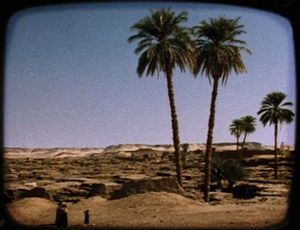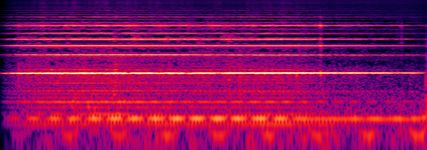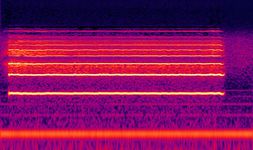Difference between revisions of "Blue Veils and Golden Sands"
Martinwguy (talk | contribs) |
Martinwguy (talk | contribs) (→Availability) |
||
| (19 intermediate revisions by the same user not shown) | |||
| Line 1: | Line 1: | ||
| − | + | {{Thumb|Blue Veils and Golden Sands screenshot}} | |
| − | In her papers Delia also calls it "Blue Veiled Men and Golden Sands", which is also what it is called in the [[BBC Radiophonic Workshop - surviving work]] catalogue. | + | Delia created [[Blue Veils and Golden Sands]] as incidental music<ref>[[Special Sound]], p.124</ref> for the episode ''The Last Caravans'' in the documentary series ''The World About Us''<ref>[[Mark Ayres]] in [[Sculptress of Sound]].</ref>. |
| + | |||
| + | In her papers Delia also calls it "Blue Veiled Men and Golden Sands", which is also what it is called in the [[BBC Radiophonic Workshop - surviving work]] catalogue, and it also gets called "The World About Us: ''The Blue Veiled Men''".<ref>[[Delia Derbyshire's Creative Process]], p.14 Table II.1.</ref> | ||
<BLOCKQUOTE> | <BLOCKQUOTE> | ||
| − | <I>This was a documentary program about the Tuareg tribe. The Tuareg tribe are nomads in the Sahara desert and I think they live by bartering, taking salt, I think it was, across the desert. In the piece [...] I tried to convey the distance of the horizon and the heat haze and then there's this very high, slow reedy sound. That indicates the strand of camels seen at a distance, wandering across the desert. That in fact was made from square waves on the valve oscillators we've just talked about, but square waves put though every filter I could possibly find to take out all the bass frequencies and so one just hears the very high frequencies. It had to be something out of this world.</I><ref>Delia in the [[Radio Scotland interview]].</ref> | + | <I>This was a documentary program about the Tuareg tribe. The Tuareg tribe are nomads in the Sahara desert and I think they live by bartering, taking salt, I think it was, across the desert. In the piece [...] I tried to convey the distance of the horizon and the heat haze, the strands of camels wandering across the desert, and then there's this very high, slow reedy sound. That indicates the strand of camels seen at a distance, wandering across the desert. That in fact was made from square waves on the valve oscillators we've just talked about, but square waves put though every filter I could possibly find to take out all the bass frequencies and so one just hears the very high frequencies. It had to be something out of this world.</I><ref>Delia in the [[Radio Scotland interview]].</ref> |
</BLOCKQUOTE> | </BLOCKQUOTE> | ||
<BLOCKQUOTE> | <BLOCKQUOTE> | ||
| Line 14: | Line 16: | ||
<BLOCKQUOTE> | <BLOCKQUOTE> | ||
Among her outstanding television work, one of her favourites was composed for a documentary for The World About Us on the Tuareg people of the Sahara desert. It still haunts me. She used her own voice for the sound of the hooves, cut up into an obbligato rhythm, and she added a thin, high electronic sound using virtually all the filters and oscillators in the workshop. | Among her outstanding television work, one of her favourites was composed for a documentary for The World About Us on the Tuareg people of the Sahara desert. It still haunts me. She used her own voice for the sound of the hooves, cut up into an obbligato rhythm, and she added a thin, high electronic sound using virtually all the filters and oscillators in the workshop. | ||
| − | {{Thumb|Coolicon | + | <BR CLEAR=ALL> |
| + | {{Thumb|Coolicon|The [[Coolicon Utility Lighting Shade]]}} | ||
| + | |||
<I>"My most beautiful sound at the time was a tatty green BBC lampshade,"</I> she recalled. <I>"It was the wrong colour, but it had a beautiful ringing sound to it. I hit the lampshade, recorded that, faded it up into the ringing part without the percussive start. | <I>"My most beautiful sound at the time was a tatty green BBC lampshade,"</I> she recalled. <I>"It was the wrong colour, but it had a beautiful ringing sound to it. I hit the lampshade, recorded that, faded it up into the ringing part without the percussive start. | ||
<BR> | <BR> | ||
| − | + | I analysed the sound into all of its partials and frequencies, and took the 12 strongest, and reconstructed the sound on the workshop's famous 12 oscillators to give a whooshing sound. So the camels rode off into the sunset with my voice in their hooves and a green lampshade on their backs."</I><ref>Brian Hodgson's [[Guardian obituary]]</ref> | |
</BLOCKQUOTE> | </BLOCKQUOTE> | ||
| − | Few could disagree with Delia's own remark on | + | Few could disagree with Delia's own remark on hearing Blue Veils again in the 90's: |
| + | <BLOCKQUOTE> | ||
| + | "<I>Doesn't it just melt you?!</I>" | ||
| + | </BLOCKQUOTE> | ||
The lampshade in question is the Coolicon Utility Lighting Shade, British Patent No 419602, Registered Design No 777912; they sometimes appear for sale on ebay. | The lampshade in question is the Coolicon Utility Lighting Shade, British Patent No 419602, Registered Design No 777912; they sometimes appear for sale on ebay. | ||
| Line 32: | Line 39: | ||
“Delia analysed the film of the Tuaregs in the desert, she counted the number of camels' feet going across and she based her music on the tempo of the camels walking along and also she recorded a single voice note of her own and repitched that to do the tune over the top.”<ref>[[Dick Mills]] interviewed on ''[[Woman's Hour 2008-07-25]].</ref> | “Delia analysed the film of the Tuaregs in the desert, she counted the number of camels' feet going across and she based her music on the tempo of the camels walking along and also she recorded a single voice note of her own and repitched that to do the tune over the top.”<ref>[[Dick Mills]] interviewed on ''[[Woman's Hour 2008-07-25]].</ref> | ||
</BLOCKQUOTE> | </BLOCKQUOTE> | ||
| + | |||
| + | =Makeup= | ||
| + | ==[[Green Lampshade]]== | ||
| + | {{Spectrogallery|Green Lampshade from DD Day 2014 trailer}} | ||
| + | ==[[Castrated Oboe]]== | ||
| + | * Original recording of Delia's voice | ||
| + | {{Spectrogallery|Castrated Oboe voice sample}} | ||
| + | * Fragments of different pitches of voice spliced into the ''[[Blue Veils]]'' melody | ||
| + | {{Spectrogallery|Castrated Oboe melody}} | ||
| + | * The melody passed through a high-pass filter and with reverberation added | ||
| + | {{Spectrogallery|Castrated Oboe melody filtered with reverb}} | ||
=Tapes= | =Tapes= | ||
| − | * [[DD243]] "Blue Veils Copy Masters" | + | * [[DD070]]: Makeup tape "Flute" |
| − | * [[DD244]] "Camels" | + | * [[DD243]]: "Blue Veils Copy Masters" |
| − | * [[TRW 6852]] "Blue Veiled Men and Golden Sands" | + | * [[DD244]]: "Camels" |
| + | * [[TRW 6852]]: "Blue Veiled Men and Golden Sands" | ||
=Copyright= | =Copyright= | ||
| Line 47: | Line 66: | ||
Type: 10/10 [?] | Type: 10/10 [?] | ||
</PRE> | </PRE> | ||
| + | |||
| + | =[[Spectrogram]]= | ||
| + | {{Spectrogallery|Blue Veils and Golden Sands}} | ||
=Availability= | =Availability= | ||
| Line 54: | Line 76: | ||
* Released on the album [[Doctor Who at the BBC Radiophonic Workshop - Volume 2: New Beginnings]] | * Released on the album [[Doctor Who at the BBC Radiophonic Workshop - Volume 2: New Beginnings]] | ||
* There is [http://music.hyperreal.org/delia/Delia%20Derbyshire%20-%20Blue%20Veils%20&%20Golden%20Sands%20(Edit).mp3 an MP3 clip at delia-derbyshire.org] | * There is [http://music.hyperreal.org/delia/Delia%20Derbyshire%20-%20Blue%20Veils%20&%20Golden%20Sands%20(Edit).mp3 an MP3 clip at delia-derbyshire.org] | ||
| − | |||
=References= | =References= | ||
Latest revision as of 22:13, 19 February 2023
Delia created Blue Veils and Golden Sands as incidental music[1] for the episode The Last Caravans in the documentary series The World About Us[2].
In her papers Delia also calls it "Blue Veiled Men and Golden Sands", which is also what it is called in the BBC Radiophonic Workshop - surviving work catalogue, and it also gets called "The World About Us: The Blue Veiled Men".[3]
This was a documentary program about the Tuareg tribe. The Tuareg tribe are nomads in the Sahara desert and I think they live by bartering, taking salt, I think it was, across the desert. In the piece [...] I tried to convey the distance of the horizon and the heat haze, the strands of camels wandering across the desert, and then there's this very high, slow reedy sound. That indicates the strand of camels seen at a distance, wandering across the desert. That in fact was made from square waves on the valve oscillators we've just talked about, but square waves put though every filter I could possibly find to take out all the bass frequencies and so one just hears the very high frequencies. It had to be something out of this world.[4]
mostly created using electronic oscillators - severely high-pass filtered - to give the "shimmering heat haze" backdrop to the Tuareg tribesmen weaving slowly across the screen of a period documentary. Delia has since referred to the piece as including her "castrated oboe", but the only non-electronic source really recorded is her voice, cut up and re-pieced.[5]
phenomenally atmospheric; such is its surround-sound quality that it totally transcends the narrow constraints of simply coming from my speakers, instead filling the room, my consciousness, the air itself. And yet virtually nothing happens...[6]
Among her outstanding television work, one of her favourites was composed for a documentary for The World About Us on the Tuareg people of the Sahara desert. It still haunts me. She used her own voice for the sound of the hooves, cut up into an obbligato rhythm, and she added a thin, high electronic sound using virtually all the filters and oscillators in the workshop.
"My most beautiful sound at the time was a tatty green BBC lampshade," she recalled. "It was the wrong colour, but it had a beautiful ringing sound to it. I hit the lampshade, recorded that, faded it up into the ringing part without the percussive start.
I analysed the sound into all of its partials and frequencies, and took the 12 strongest, and reconstructed the sound on the workshop's famous 12 oscillators to give a whooshing sound. So the camels rode off into the sunset with my voice in their hooves and a green lampshade on their backs."[7]
Few could disagree with Delia's own remark on hearing Blue Veils again in the 90's:
"Doesn't it just melt you?!"
The lampshade in question is the Coolicon Utility Lighting Shade, British Patent No 419602, Registered Design No 777912; they sometimes appear for sale on ebay.
Contents
Structure
“The piece is just over three minutes long, and begins with percussive sounds that seems to fade in from the distance, almost like a church bell. This is followed by the central “theme”, with the “shimmering” quality. The percussion is heard intermittently. There are other sounds “melting” in and the piece seems to meander aimlessly, and the piece does not achieve a climax. Neither the sounds (instruments) nor the melody are recognisable. It simply becomes, fills the space, at time piercingly so, and then ceases to become. Overall, the effect is of something slowly approaching, and then slowly moving away.”[8]
“Delia analysed the film of the Tuaregs in the desert, she counted the number of camels' feet going across and she based her music on the tempo of the camels walking along and also she recorded a single voice note of her own and repitched that to do the tune over the top.”[9]
Makeup
Green Lampshade
Castrated Oboe
- Original recording of Delia's voice
- Fragments of different pitches of voice spliced into the Blue Veils melody
- The melody passed through a high-pass filter and with reverberation added
Tapes
- DD070: Makeup tape "Flute"
- DD243: "Blue Veils Copy Masters"
- DD244: "Camels"
- TRW 6852: "Blue Veiled Men and Golden Sands"
Copyright
The Performing Right Society's list of works by Delia Ann Derbyshire has:
Title: Blue Veils And Golden Sands Writer(s): Derbyshire Delia Ann Publisher: BBC Worldwide Music Work number: T-010.035.839-1 293145Q Type: 10/10 [?]
Spectrogram
Availability
- Brooadcast on 30 June 1968 at 7.25pm on BBC2.[10]
- Released on the album BBC Radiophonic Music" in 1971.
- Released on the album Music from The BBC Radiophonic Workshop in 2003.
- Released on the album Doctor Who at the BBC Radiophonic Workshop - Volume 2: New Beginnings
- There is an MP3 clip at delia-derbyshire.org
References
- ↑ Special Sound, p.124
- ↑ Mark Ayres in Sculptress of Sound.
- ↑ Delia Derbyshire's Creative Process, p.14 Table II.1.
- ↑ Delia in the Radio Scotland interview.
- ↑ delia-derbyshire.org
- ↑ Robin Carmody in Wee also have sound-houses
- ↑ Brian Hodgson's Guardian obituary
- ↑ Breege Brennan's thesis.
- ↑ Dick Mills interviewed on Woman's Hour 2008-07-25.
- ↑ The Tape Library List's entry for TRW 6852.





